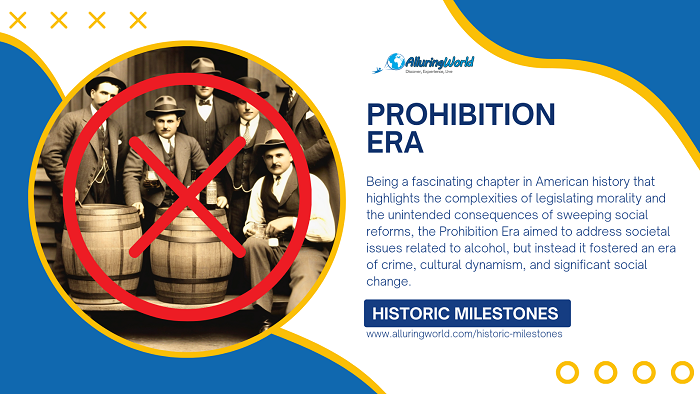Read time ca. 4 minutes
The Prohibition Era that spanned from 1920 to 1933 in the United States, was a period that was marked by the nationwide ban on the production, importation, transportation, and sale of alcoholic beverage, as enacted through the 18th Amendment and the Volstead Act, Prohibition aimed to curb alcohol consumption and its associated social problems, however, it led to unintended consequences, including the rise of organized crime, speakeasies, and significant cultural shifts.
The Roots of Prohibition:
The Prohibition Era was the result of decades of efforts by the temperance movement, which advocated for the prohibition of alcohol consumption, and supporters of prohibition which included religious groups and social reformers, believed that alcohol was the root cause of many social problems, such as poverty, crime, and family breakdown, so they argued that alcohol consumption led to moral decay, increased violence, and economic hardship.
The temperance movement gained significant momentum in the late 19th and early 20th centuries, and in the end culminated in 1919 with the passage of the 18th Amendment to the United States Constitution. This amendment prohibited the manufacture, sale, or transportation of intoxicating liquors within, the importation thereof into, or the exportation thereof from the United States and all territory subject to the jurisdiction thereof for beverage purposes. The Volstead Act that was passed too in 1919, additionally provided the specific enforcement measures for the 18th Amendment.
Life Under Prohibition:
While intended to create a healthier and more moral society, the Prohibition ultimately proved difficult to enforce, and while initial alcohol consumption rates declined, the demand for alcohol still remained strong. This created a lucrative black market for illegal alcohol since it fueled the rise of organized crime, so bootleggers smuggled alcohol from other countries or produced it domestically in clandestine operations. In addition, speakeasies, which were hidden bars operating illegally, became popular social hubs because they often required secret passwords for entry, and these establishments fostered a vibrant, albeit illicit, nightlife scene, attracting a diverse clientele.
Nevertheless, the Prohibition also had unintended consequences, such as increased crime rates associated with the illegal alcohol trade, so in contrast the rise of organized crime figures like Al Capone underscored the dangers of the black market. Furthermore, Prohibition weakened public trust in law enforcement as corruption became more prevalent, hence why the era ultimately demonstrated the limitations of government intervention in personal choices and the difficulty of enforcing laws that were opposite from the deeply ingrained social norms of the time.
The Rise of Organized Crime:
One the greatest unintended consequences of the Prohibition was the rise of organized crime which was not within the perspective of the politicians that were enforcing and pushing for the 18th Amendment. The prohibition of alcohol created a lucrative black market, where the production and distribution of liquor became highly profitable, and underworld figures such as Al Capone capitalized on this opportunity, forming criminal enterprises that controlled the illegal alcohol trade, but also bootlegging became a cornerstone of these criminal organizations.
These criminal syndicates employed violence to maintain control over their territories and eliminate competition, and quite often gang wars erupted as rival factions fought for dominance in the lucrative alcohol market. The profits generated from bootlegging allowed these criminal organizations to expand their influence beyond the alcohol trade, infiltrating legitimate businesses, bribing officials, and exerting control over local politics, so this period saw the emergence of powerful criminal organizations that would continue to shape the American underworld for decades to come.
Cultural Shifts and the Jazz Age:
As the Prohibition occurred during the Roaring Twenties which was a decade of significant economic prosperity and rapid social change, and this period was marked by a vibrant cultural scene, with the emergence of jazz music, the rise of the “flapper” as a symbol of female liberation, and a general loosening of social norms. Speakeasies became the cultural melting pots where people from diverse backgrounds mingled through the enjoyment of live jazz music and indulging in forbidden pleasures.
The Roaring Twenties also witnessed an increase in women’s visibility and participation in public life because the fight for women’s suffrage had culminated in the 19th Amendment which granted women the right to vote. This, along with changing social attitudes, led to greater social freedoms for women who entered the workforce in larger numbers, pursued higher education, and challenged traditional gender roles. So, as a result of all this, the flapper with her short skirts, bobbed hair, and independent attitude, became an iconic symbol of this changing social landscape.
The End of Prohibition:
One of the reasons for the end of the Prohibition Era was the Great Depression which significantly contributed to the repeal of it. As the nation grappled with economic hardship, the potential revenue from taxing the sale of alcohol became increasingly appealing so the government saw a potential source of income to alleviate the financial strain on the country. Furthermore, the failure of the Prohibition to curb crime and the widespread disregard for the law eroded public support, and as organized crime thrived during the Prohibition, the illicit alcohol trade often fueled violence and corruption. This combination of factors led to a growing public sentiment in favor of repealing the 18th Amendment, and in 1933, the 21st Amendment was ratified, officially ending the Prohibition Era and allowing for the legal sale and consumption of alcohol once again.
Conclusion:
To sum it all, the Prohibition Era is a fascinating chapter in American history that highlights the complexities of legislating morality and the unintended consequences of sweeping social reforms, and while it aimed to address societal issues related to alcohol, it instead fostered an era of crime, cultural dynamism, and significant social change. The lessons learned from this period continue to inform contemporary discussions on regulation, personal freedoms, and the role of government in shaping societal behavior.

